
 |
Tea Clipper |
 |
| from TeaAntiques.com | ||
| Edition Seventy Nine |
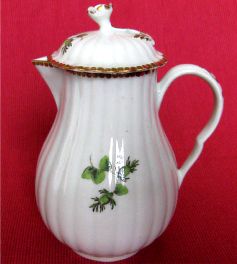
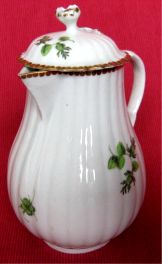
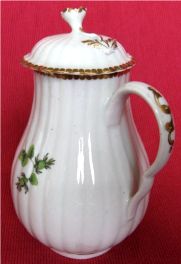
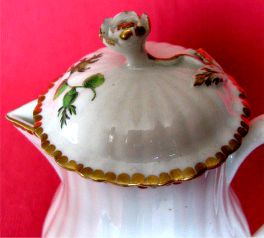
My Featured Antique is a fine and beautiful First Period Worcester pear shaped milk jug and cover, with flower finial c1775. Decorated in green monochrome hand painted fruits and flowers, this is a charming and delightful milk jug and cover with a vertically moulded body and embellished with very fine gilding. This is certainly a beautiful early Worcester jug that is in excellent condition for the connoisseur collector.
More details of this item and other tea related antiques can be found by visiting my web site at www.TeaAntiques.com.
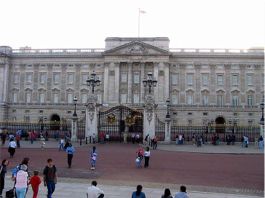 Buckingham Palace, London is the official home of the reigning monarch, Her
Majesty The Queen Elizabeth II. It is effectively the headquarter where
Her Majesty carries out official duties as the Head of State of the United
Kingdom and Head of the Commonwealth. The Palace is generally home to The Queen,
although at the weekends, she tends to stay at Windsor Castle. When the Queen is
in residence, her Royal Standard is flown from the flag staff on top of the
front of the Palace. This is replaced with a Union Flag when she is not in
residence. Buckingham Palace State Rooms and Garden are now open to the public
during August and September, during which time The Queen is at Balmoral, in
Scotland for her annual holiday. The Queens Gallery and Royal Mews however, are
open to the public all year round.
Buckingham Palace, London is the official home of the reigning monarch, Her
Majesty The Queen Elizabeth II. It is effectively the headquarter where
Her Majesty carries out official duties as the Head of State of the United
Kingdom and Head of the Commonwealth. The Palace is generally home to The Queen,
although at the weekends, she tends to stay at Windsor Castle. When the Queen is
in residence, her Royal Standard is flown from the flag staff on top of the
front of the Palace. This is replaced with a Union Flag when she is not in
residence. Buckingham Palace State Rooms and Garden are now open to the public
during August and September, during which time The Queen is at Balmoral, in
Scotland for her annual holiday. The Queens Gallery and Royal Mews however, are
open to the public all year round.
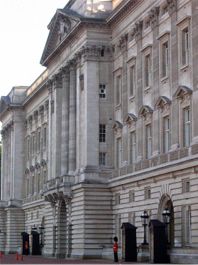
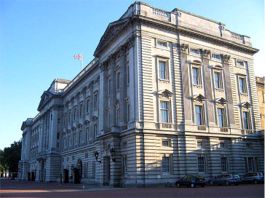
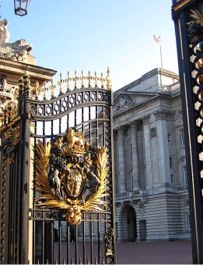
Buckingham Palace is in fact the youngest of the Royal Palaces. Before it became headquarters of the Royal Household, the Tower of London, Windsor Castle, Hampton Court, St James Palace served as the earlier Palaces. Buckingham House, as it was in the Eighteenth century, was bought by King George III as a private residence for his wife Queen Charlotte in 1762. At this time, Buckingham House stood on the extremity of the city of Westminster at the Western end of the Tudor hunting park of St James's.
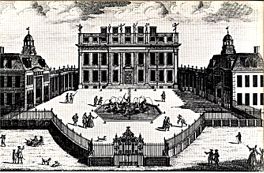 An older Buckingham House was completely destroyed by fire in 1674 and the Duke
of Buckingham, the owner, re-built the house, which later was added on to form
the Palace we see today. The Buckingham House built from 1674, comprised a
Baroque central house with two side wings. each linked to the house with a
walled Logia. It was this main block and side wings which dictated the sides of
the present Palace, which is built round a quadrangle.
An older Buckingham House was completely destroyed by fire in 1674 and the Duke
of Buckingham, the owner, re-built the house, which later was added on to form
the Palace we see today. The Buckingham House built from 1674, comprised a
Baroque central house with two side wings. each linked to the house with a
walled Logia. It was this main block and side wings which dictated the sides of
the present Palace, which is built round a quadrangle.
Between 1762 and 1776, George III transformed the house, both inside and out, at a cost of £73,000. The east front of the house was re-modelled, removing the Baroque features. The elaborate and high railings with gates were also swept away in favour of lower, less formal railings and gates. In 1775, Buckingham House was settled on Queen Charlotte in exchange for Somerset House. The interior of the house was very elaborate on the first floor, which were the Queens Chambers. Here the ceilings were fashioned by Robert Adam. On the ground floor, which were the Kings Chambers, they were much more subdued in their decoration.
Following the death of George III in 1820, his son King George IV was looking for a Palace in which he could entertain on much larger scale than George III. His own house, Carlton House along Pall Mall was not suitable. It was then decided to give Buckingham Palace a makeover to become the official residence of the King. To this end, John Nash, the architect, was brought in. John Nash had already been employed to bring the King's Mews from Charing Cross to a new stable complex (now the Royal Mews) adjacent to Buckingham House.
Initially, the plans submitted by Nash were to essentially enlarge the plan of Buckingham House. The central block of the existing house was extended westward and to the north and south, and the two wings to the east were rebuilt using the same architectural style that he had employed for the grand terraces around Regents Park. The effect of these changes was to make the now 'Palace' larger and more formal than in the time of George III. The go ahead for this work was granted by a bill of Parliament in 1825. At the centre of the new East front was a large double portico and in the centre of the open courtyard was proposed a triumphant arch through which ceremonial processions could pass.
The cost of this work was extremely high and the Palace was hardly habitable by the time George IV died in 1830. Continuing the improvements through the reign of William IV and by the time Queen Victoria came to the throne in 1832, a total of £800,000 had been expended on the work.
During the reign of Queen Victoria, with her large family, growing court and need for more space for lavish entertaining, she requested the Palace be extended. A new wing was proposed across the open front to completely enclose Nash's forecourt on its eastern side. Edward Blore designed the new wing. It was decided to face this new wing with French Limestone. Until now, this Limestone had only been used for interior work and it was found that by 1866, the facade of the Palace had started to deteriorate in the heavily polluted London air.
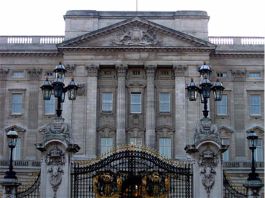
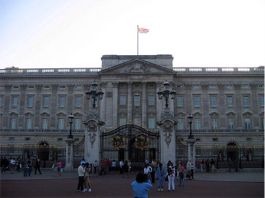
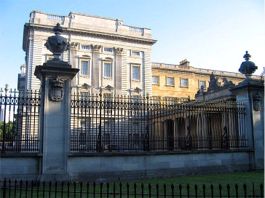
Blore's new wing was designed with a facade three stories high, which has
obscured the public view of the
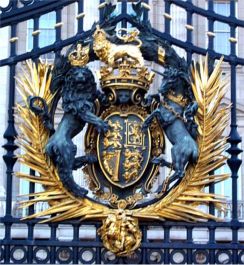 original Nash buildings behind that are set
around the courtyard. the building of this new wing took place between 1847 to
1850. New railings and carved stone piers were put up round the front of the
Palace. The central gates were hung on massive carved stone piers surmounted by
stone carved Dolphins, but in a later remodelling in 1913, these were reset at a
new location. The new wing necessitated that the marble arch, which had been
placed in the centre of the forecourt, had to be removed. This was placed at the
edge of Hyde Park and is the 'Marble Arch' that we see there today.
original Nash buildings behind that are set
around the courtyard. the building of this new wing took place between 1847 to
1850. New railings and carved stone piers were put up round the front of the
Palace. The central gates were hung on massive carved stone piers surmounted by
stone carved Dolphins, but in a later remodelling in 1913, these were reset at a
new location. The new wing necessitated that the marble arch, which had been
placed in the centre of the forecourt, had to be removed. This was placed at the
edge of Hyde Park and is the 'Marble Arch' that we see there today.
Queen Victoria's decision to sell off Brighton Pavilion to the Brighton Corporation had helped to fund the building of the new wing for Buckingham Palace. Fixtures and fittings were removed from Brighton Pavilion to be used in the fitting out of the new wing, this was an economy measure insisted upon by the Board of Works. However, in reality it probably cost more to re-use these existing fixtures and fittings, rather than to build new.
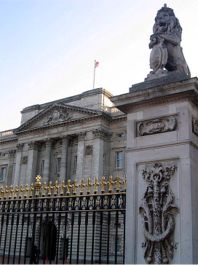 In 1912, the façade of the new wing, whose French Limestone had by now severely
deteriorated, was refaced again, this time in Portland stone blocks. The new
design of the facade, by Aston Webb and Brook, kept the balcony of the original
design, as it was required for members of the Royal family to make their
appearances to their public. The central frieze in the pediment, was carved with
the royal arms which measure 8m (25 feet across).
In 1912, the façade of the new wing, whose French Limestone had by now severely
deteriorated, was refaced again, this time in Portland stone blocks. The new
design of the facade, by Aston Webb and Brook, kept the balcony of the original
design, as it was required for members of the Royal family to make their
appearances to their public. The central frieze in the pediment, was carved with
the royal arms which measure 8m (25 feet across).
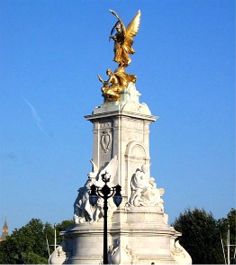 Finally, with the completion of the Queen Victoria Memorial Scheme, with the
huge memorial to her standing at the top of the Mall outside the Palace
railings, completes the Palace to how we see Buckingham Palace today. It is this
view of the new wing that is synonymous with the tourist's image of Buckingham
Palace and one that is recognised world wide.
Finally, with the completion of the Queen Victoria Memorial Scheme, with the
huge memorial to her standing at the top of the Mall outside the Palace
railings, completes the Palace to how we see Buckingham Palace today. It is this
view of the new wing that is synonymous with the tourist's image of Buckingham
Palace and one that is recognised world wide.
A tour of the state rooms begins by entering the Palace, not through the front, but round the East side via the Ambassadors' entrance. This entrance, with its Ionic portico was reserved, as the name suggests, for foreign ambassadors to the Court of St James's and others, such as senior members of Government and of the diplomatic or armed services, with the special privilege know as the entree. From this entrance a narrow passageway takes you though into the Grand Entrance.
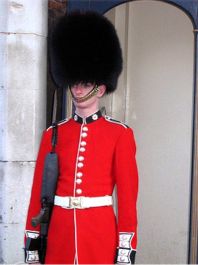 The principle entry into the Grand Hall is via the covered carriage entrance
from the courtyard. It is from here that the red carpeted steps would lead the
Queen or her guests into the Grand Hall. This Grand Hall is where the Queen's
guests for functions such as garden parties or receptions would arrive. It is
also where the Queen would welcome heads of state and present to them the
members of her Household on the first day of their visit. This room was designed
by Nash and incorporates marble columns with flights of steps between them. The
white and delicately gilded decoration provide a light and very pleasant Hall. A
rich red carpet on the floor provides the main boost of colour. To the left side
of the Hall is the Grand Staircase. A single flight of red carpeted steps leads
up to a half landing. Here, the staircase divides into two, both ways sweeping
back round to take you up to the State rooms. There is also a staircase leading
straight on from the half landing which leads up to the East Gallery. The tour
takes you up round the curved stairs towards the State apartments. The
magnificent gilt-bronze balustrade are the work of Samuel Parker and were
installed 1828-9. The design of these beautiful scrolling balustrades echo the
decoration of the gilded plasterwork around the walls.
The principle entry into the Grand Hall is via the covered carriage entrance
from the courtyard. It is from here that the red carpeted steps would lead the
Queen or her guests into the Grand Hall. This Grand Hall is where the Queen's
guests for functions such as garden parties or receptions would arrive. It is
also where the Queen would welcome heads of state and present to them the
members of her Household on the first day of their visit. This room was designed
by Nash and incorporates marble columns with flights of steps between them. The
white and delicately gilded decoration provide a light and very pleasant Hall. A
rich red carpet on the floor provides the main boost of colour. To the left side
of the Hall is the Grand Staircase. A single flight of red carpeted steps leads
up to a half landing. Here, the staircase divides into two, both ways sweeping
back round to take you up to the State rooms. There is also a staircase leading
straight on from the half landing which leads up to the East Gallery. The tour
takes you up round the curved stairs towards the State apartments. The
magnificent gilt-bronze balustrade are the work of Samuel Parker and were
installed 1828-9. The design of these beautiful scrolling balustrades echo the
decoration of the gilded plasterwork around the walls.
The first room that you enter is the Guard Chamber. This small room was designed on the old fashioned Palace layouts at Hampton Court and Windsor, for a guard to be sited for the protection of the monarch. By the time this Palace was built such a guard was no longer required, so this room is beautifully decorated and is in effect an anti-chamber. It has been likened to the inside of a jewel casket, and now has in it statues of Queen Victoria and Prince Albert. Passing on through this small room leads into the elegantly beautiful Green Drawing Room, so called as it is hung with magnificent green silk. A set of glittering crystal glass chandeliers hang at each corner, these may have come from the Prince Regent's Carlton House when he became King George IV. The ornate gilded ceiling is formed in a geometric design and has a frieze border of wreaths and swags in gold. The white marble mantle pieces are adorned with sets of eighteenth century Sèvres porcelain vases, in keeping with the green of the silk covered walls. Around the room are some very large portraits of various members of the Royal family and relations through the ages.
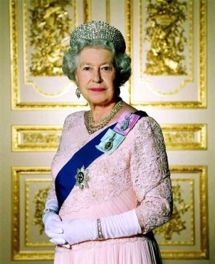 Continuing through a pair of doors you enter the room we are all eagerly
expecting to see, Throne Room. Against the far wall facing you are two golden
carved thrones, each covered in a rich dark pink silk. These were made in 17th
century style for the coronation of the Queen in 1953. One bears the initials
'ER' of Her Majesty the Queen, the other 'P' for Philip, Duke of Edinburgh.
Throne chairs made for previous monarchs' coronations, including George VI and
Queen Victoria are to be seen around the room. Above the Queen and Duke of
Edinburgh's thrones is a dramatic canopy and back cloth in red and edged with
gold. In front of the thrones; Nash has designed into the ceiling a proscenium
arch, this cleverly separates the throne area from the rest of the room. This
arch includes two life-sized winged genii each holding the end of a
gilded foliate swag, within the centre a roundel containing the initials of
King George IV. A very ornate ceiling is to be seen, with gilded ornamentation
and a curved frieze, which has a gilded lattice work decoration, with shields
spaced around it. These shields contain the arms of the Kingdoms of England,
Scotland, Ireland and the House of Hanover.
Continuing through a pair of doors you enter the room we are all eagerly
expecting to see, Throne Room. Against the far wall facing you are two golden
carved thrones, each covered in a rich dark pink silk. These were made in 17th
century style for the coronation of the Queen in 1953. One bears the initials
'ER' of Her Majesty the Queen, the other 'P' for Philip, Duke of Edinburgh.
Throne chairs made for previous monarchs' coronations, including George VI and
Queen Victoria are to be seen around the room. Above the Queen and Duke of
Edinburgh's thrones is a dramatic canopy and back cloth in red and edged with
gold. In front of the thrones; Nash has designed into the ceiling a proscenium
arch, this cleverly separates the throne area from the rest of the room. This
arch includes two life-sized winged genii each holding the end of a
gilded foliate swag, within the centre a roundel containing the initials of
King George IV. A very ornate ceiling is to be seen, with gilded ornamentation
and a curved frieze, which has a gilded lattice work decoration, with shields
spaced around it. These shields contain the arms of the Kingdoms of England,
Scotland, Ireland and the House of Hanover.
George IV, who commissioned John Nash the architect to design this room, did not live to see it completed. It was his brother, William IV who has put his own bust in place of honour above the door. Queen Victoria was the first Monarch to make use of this Throne Room and King George V used it for investitures.
Leaving the Throne Room to the left you enter the Picture Gallery, the centre of the Palace. This very long gallery has a barrelled opaque glass roof which allows soft light to lighten the gallery. Not just a picture gallery, today the gallery is used by the Queen to host very large receptions of up to 700 guests. The walls are covered in a pink 'flock' patterned silk, providing a soft coloured background for the richly gilded framed pictures to hang. The Picture Gallery contains some very fine masterpieces including works by Canaletto, Rubens and many other famous artists. The doors of many of the state rooms, including this Picture Gallery have mirrored doors, giving a sense of more space and creating an even lighter feel to the rooms.
At the end of the Picture Gallery, passing through a small room called the Tapestry Room, you emerge into another long picture gallery known as the East Gallery. This as with the Picture Gallery, has a glass roof to it to allow the light into the gallery to illuminate the room and paintings. This Gallery is part of the Victorian improvement to the Palace to enlarge it. Mirrored pairs of doors are used to great effect in making the room even lighter. One of the large paintings within the gallery is a painting by Sir George Hayter of Queen Victoria's Coronation in 1838. Victoria sits proudly upon her gilded Throne surrounded by Lords and Ladies in their red robes trimmed with ermine.
At the end of the East Gallery, another of Queen Victoria's additions, The Ballroom. Before entering the Ballroom to the left of the east gallery is The Ball Supper Room. This was designed so that guests at large Ball could take refreshments, numbers of guests could be several hundred. Today, it is a room where The Queen hosts a Diplomatic reception and Christmas dance.
The Ballroom itself is an elegant, but quite plain room, the walls in simple white with quite restrained gilt decoration. This simple decoration is a perfect foil for the two red Thrones at the far end of the Ballroom set up on a stepped platform. A beautiful red velvet canopy with its gilt frame and edgings sits high above the Thrones. The red screen behind the Thrones is embellished with a large Royal Arms. At the other end of the 34 foot long room up in the gallery is a massive pipe organ. This organ was originally supplied for the Royal Pavilion in Brighton in 1817, but removed to this place in Buckingham Palace after the Pavilion was sold off to Brighton Corporation in 1848. This Ballroom is used for twenty investiture ceremonies each year, bestowing honours on those published in the New Year and Birthday Honours List. These investitures are not always carried out by the Queen, Prince Charles and deputies also carry out this rôle.
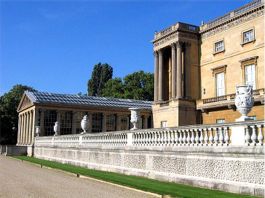
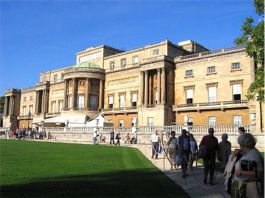
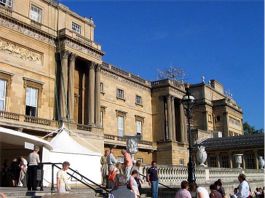
Doors to the right of the Thrones lead through the suite of State Rooms on the garden side of the Palace. Passing through the West Gallery you find yourself entering the State Dining Room. All the rooms along this side of the Palace enjoy the late afternoon sunshine which floods in through the windows. From these windows you can also enjoy the view of the naturalistic gardens with their sense of tranquillity, unlike the rest of London outside the Palace walls.
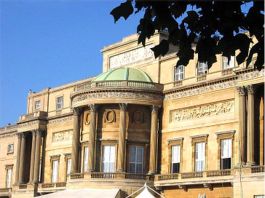 This State Dining Room houses a long mahogany table around which are many
gilt framed sabre legged chairs, each with a red velvet seat. On the table some
large silver gilt items, including wine coolers by Paul Storr, 1812 and a centre
piece designed by Prince Albert and has modelled into it the Royal couple's
favourite dogs. The walls of the State Dining Room are now covered with a deep
crimson damask, a change to the room made in 1965-6. The white and gilt ornate
ceiling has roundels within the frieze which contain the initials of King
William and also Queen Victoria and Prince Albert. The fact that Victoria and
Albert's initials also appear in the decoration indicates that this Nash
designed room for William IV was not completed before the death of William IV in
1837. Some fine portraits adorn the walls, including full length portraits of
King George III and Queen Charlotte, King William IV and Queen Adelaide and
taking centre stage above the central white marble fireplace, King George IV in
his Garter robes c1820.
This State Dining Room houses a long mahogany table around which are many
gilt framed sabre legged chairs, each with a red velvet seat. On the table some
large silver gilt items, including wine coolers by Paul Storr, 1812 and a centre
piece designed by Prince Albert and has modelled into it the Royal couple's
favourite dogs. The walls of the State Dining Room are now covered with a deep
crimson damask, a change to the room made in 1965-6. The white and gilt ornate
ceiling has roundels within the frieze which contain the initials of King
William and also Queen Victoria and Prince Albert. The fact that Victoria and
Albert's initials also appear in the decoration indicates that this Nash
designed room for William IV was not completed before the death of William IV in
1837. Some fine portraits adorn the walls, including full length portraits of
King George III and Queen Charlotte, King William IV and Queen Adelaide and
taking centre stage above the central white marble fireplace, King George IV in
his Garter robes c1820.
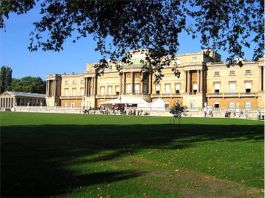 Beyond the State Dining Room are the Blue Drawing Room, The bayed Music Room and
the White drawing Room. Queen Mary had the walls of the Blue Drawing Room
covered in blue flock, previously it had been hung with crimson silk and was
simply known as the South Drawing Room. There are 30 giant order columns around
the room, painted to look like Onyx, these before 1860 had been painted to
resemble marble. A richly decorated room it has four beautiful crystal glass
chandeliers in the corners of the room.
Beyond the State Dining Room are the Blue Drawing Room, The bayed Music Room and
the White drawing Room. Queen Mary had the walls of the Blue Drawing Room
covered in blue flock, previously it had been hung with crimson silk and was
simply known as the South Drawing Room. There are 30 giant order columns around
the room, painted to look like Onyx, these before 1860 had been painted to
resemble marble. A richly decorated room it has four beautiful crystal glass
chandeliers in the corners of the room.
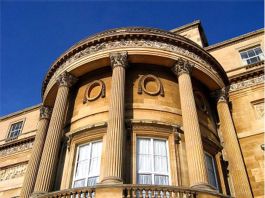 The bayed Music Room between the Drawing Rooms has a most amazing white and gilt
decorated dome from which is suspended a huge early nineteenth chandelier and is
one of a pair hanging in the room. With the large windows around the bay light
flood into the room. The windows are dressed with red and gilt curtains with
arched pelmets. Between each window stands a blue column, imitating Lapis Lazuli
with gilded Corinthian capitols, there are sixteen columns in total around the
room. A black Broadwood grand piano sits in the bay and the room is still used
for private recitals. It was in this room that The Queen's three eldest children
were baptised with water brought from the River Jordan.
The bayed Music Room between the Drawing Rooms has a most amazing white and gilt
decorated dome from which is suspended a huge early nineteenth chandelier and is
one of a pair hanging in the room. With the large windows around the bay light
flood into the room. The windows are dressed with red and gilt curtains with
arched pelmets. Between each window stands a blue column, imitating Lapis Lazuli
with gilded Corinthian capitols, there are sixteen columns in total around the
room. A black Broadwood grand piano sits in the bay and the room is still used
for private recitals. It was in this room that The Queen's three eldest children
were baptised with water brought from the River Jordan.
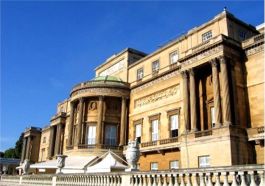
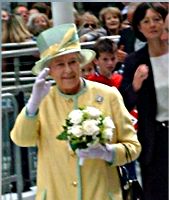 The final room to be viewed on the first floor is the White Drawing Room and in
my mind one of the prettier rooms. Painted white with a magnificent decorative
ceiling highlighted in gold. This decoration was the inspiration of Queen
Alexandra, whose most charming full length portrait hangs above the fireplace.
This painting of her was carried out in 1906 and she is seen wearing a white
silk dress and has on her head a diamond crown which had been made for Queen
Victoria. She has a wonderful look of charm and elegance.
The final room to be viewed on the first floor is the White Drawing Room and in
my mind one of the prettier rooms. Painted white with a magnificent decorative
ceiling highlighted in gold. This decoration was the inspiration of Queen
Alexandra, whose most charming full length portrait hangs above the fireplace.
This painting of her was carried out in 1906 and she is seen wearing a white
silk dress and has on her head a diamond crown which had been made for Queen
Victoria. She has a wonderful look of charm and elegance.
There is a very fine roll top desk within the White Drawing Room, French c1775 and may have been made for one of the daughters of Louis XV. The marquetry and ormolu mounts are most excellent. To one side at the end of the room is a very carefully concealed door that looks like a bookcase with a table below it, this is used by the Queen to enter the room from her private apartments.
Making your way out of the White Drawing Room you descend a staircase known as The Ministers' Staircase. This takes you to the Marble Hallway towards the back of the Grand Hall. It contains a collection of marble statues and sculptures. When you reach the Grand Hall, you turn right, through the Bow Room, which is immediately below the Music Room and through doors to immerge out onto the terrace and gardens.
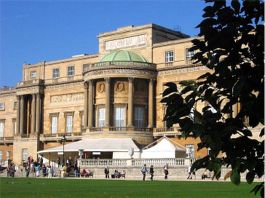
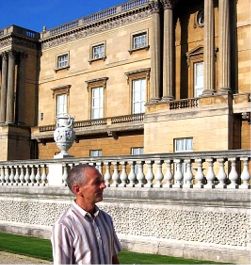
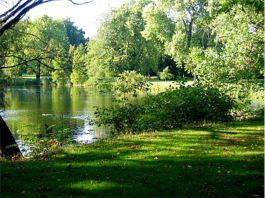
Walking round the perimeter of the garden, you can look back to admire the West Front of the Palace, much to the original design of John Nash. The West Front is approximately 73 yards (80 meters) in length. The central raised half dome and raised attic are of a later date. The relief within the walls to either side of the bay are to designs by John Flaxman and carved by Sir Richard Westmancott in Malta stone. Completed in 1832 they depict scenes from the life of Alfred the Great.
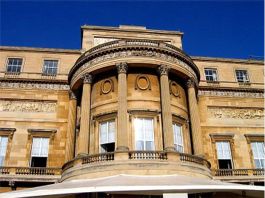
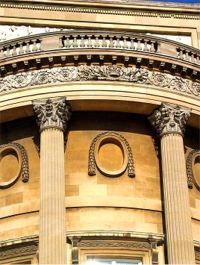
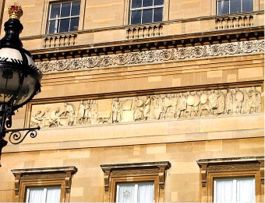
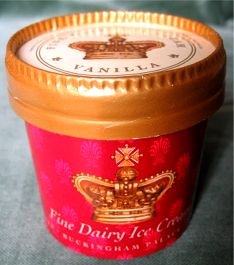 The naturalistic Palace garden contains the large sweeping lawn, the scene of
the now famous garden parties. Beyond this, a large lake with trees and shrubs
rather than any form of formal bedding. It is a wild life haven in the heart of
London. Although there is nowhere at the Palace to buy teas, at the far end of
the garden is a kiosk selling Buckingham Palace ice-cream tubs in Vanilla,
Strawberry or Chocolate. On a fine day in September is was jus the perfect thing
to have. I enjoyed a chocolate tub; very good it was too.
The naturalistic Palace garden contains the large sweeping lawn, the scene of
the now famous garden parties. Beyond this, a large lake with trees and shrubs
rather than any form of formal bedding. It is a wild life haven in the heart of
London. Although there is nowhere at the Palace to buy teas, at the far end of
the garden is a kiosk selling Buckingham Palace ice-cream tubs in Vanilla,
Strawberry or Chocolate. On a fine day in September is was jus the perfect thing
to have. I enjoyed a chocolate tub; very good it was too.
There are a number of souvenir shops within the Palace, Mews and Queen's Gallery in which you can find some tea related souvenirs including, china teapots, cups and saucers, and teas all commemorative wares. Who knows, these may become antiques of the future? Anyway, they provide a very nice memento of your visit.
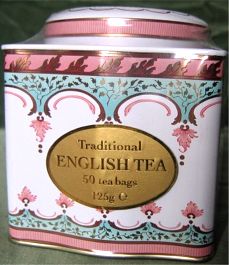
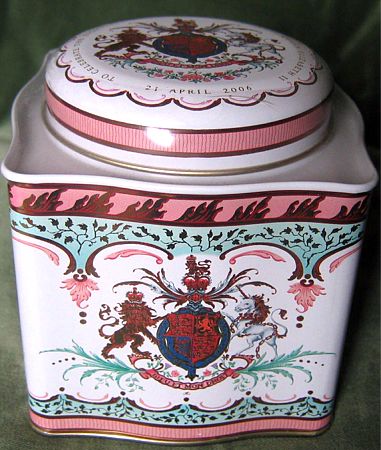
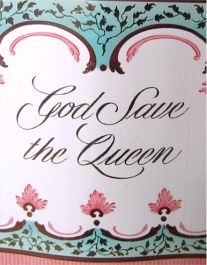
The day viewing the State Rooms of the Palace was a day well spent and one that I shall remember fondly in years to come. If you get the opportunity to visit the Palace during the period in which it opens, then I strongly recommend it.
Admission includes free re-admission to all the open areas for twelve months - allowing you to take a second look at bits you might have missed. Very good value!
Buckingham Palace London www.royal.gov.uk
Local Map:
Click here
Map courtesy of www.streetmap.co.uk
To review past newsletters, just follow this link:
Past newsletters.
To subscribe to this free newsletter -
Click here